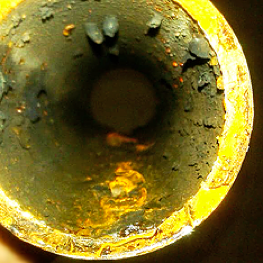Microbiologically influenced Corrosion (MIC) is caused by biological organisms (microbes) that form bacterial colonies within fire sprinkler system piping. MIC can degrade or cause failure in many different types of systems including boilers, cooling towers, heat exchangers, process piping and of course fire protection. The ultimate effect of MIC is the premature failure of metal components in closed loop piping systems and it can affect both wet and dry pipe fire sprinkler and standpipe systems. MIC can actively or passively attack the metal compounds in steel piping and active MIC infections will continue to establish new corrosion areas unless arrested and remediated. Factors that contribute to the development of corrosion are pH, localized material defects, the presence of nutrients, temperature, lack of flow, and oxygen concentration
The types of bacteria associated with MIC in sprinkler systems are:
- Sulfate-Reducing Bacteria (SRB) – bacteria that converts sulfate ions to sulfides (including hydrogen sulfide) and can thrive in low oxygen environments. SRB requires sufficient organic nutrients.
- Iron-Related Bacteria (IRB) – bacteria that converts soluble iron ions (ferrous) to insoluble iron ions (ferric). IRB is widely found throughout the built environment as they may be aerobic or anaerobic.
- Low Nutrient Bacteria (LNB) – microbes/ bacteria that grow in environments, such as potable water, with very low concentrations of nutrients. Also referred to as Slime-Producing Bacteria, LNB can form gelatinous deposits which may not be highly corrosive, but that create host sites where other MIC bacteria can grow.
- Aerobic Bacteria – bacteria that grow in the presence of free oxygen
- Anaerobic Bacteria – bacteria that grow in the absence of abundant free oxygen.
Active (aerobic) MIC is localized and most commonly the point where pinhole leaks form. Passive (anaerobic) MIC is normally found under layers of biological waste that can form a gel like mass. This mass can extend over large areas, which can foster additional deposits, which are most often seen on the bottom side of horizontal pipes. These deposits will cause flow obstruction within fire sprinkler systems. Passive MIC can attack large areas and generally account for the greatest metal loss.
Bacteria enter the system in the normal course of filling. Bacteria that can cause MIC are found in our drinking water nationwide, although normally in very low concentrations that aren’t considered unsanitary. Once it enters the piping, bacteria grow, and produce byproducts (waste) corrosive to metals, such as mild steel, stainless steel, copper and copper alloys, as as galvanized steel. These byproducts include alkalis, acids, and reducing agents such as ammonia, hydrogen sulfides, sulfuric acid, and organic acids. The bacterial waste layer can also produce tubercles and biofilms which create micro-environments on metal surfaces under the tubercles. The area under the tubercles become oxygen-depleted and support the growth of anaerobic bacteria, which feed on the pipe wall material and give off acidic byproducts that chemically attack the metal surface
MIC requires nutrients to metabolize and one of the biggest contributing factors to aggressive MIC is, ironically, the efforts by building owners and maintenance personnel to eradicate the infection by flushing systems with fresh water. This has exactly the opposite effect; the new water brings a fresh supply of oxygen that reinvigorates the bacteria and exacerbates the problem. If microbiologically influenced corrosion is suspected due to observation of slime, restrictions in flow, or leaks/pinhole leaks in pipes, the testing for the presence of MIC is warranted to determine:
- Whether bacteria related to MIC are present and, if so, their relative concentration
- The extent of the corrosion present
- The source of the corrosion
- Limits of the MIC affected system components
To date, the standard of care in the contracting community has been to completely remove and replace entire sprinkler system that are found to be infected. Protection Design and its partners have developed a stepped program to accurately diagnose and gauge the extent of the infection and remediate the impairments. The only proven way to selectively address MIC is to chemically clean and treat the system, pursuant to determining the extent of the infection. This combination of videography and forensic analysis is the most cost-effective alternative to complete system replacement available and normally entails removal of only a small portion of the most damaged piping.
